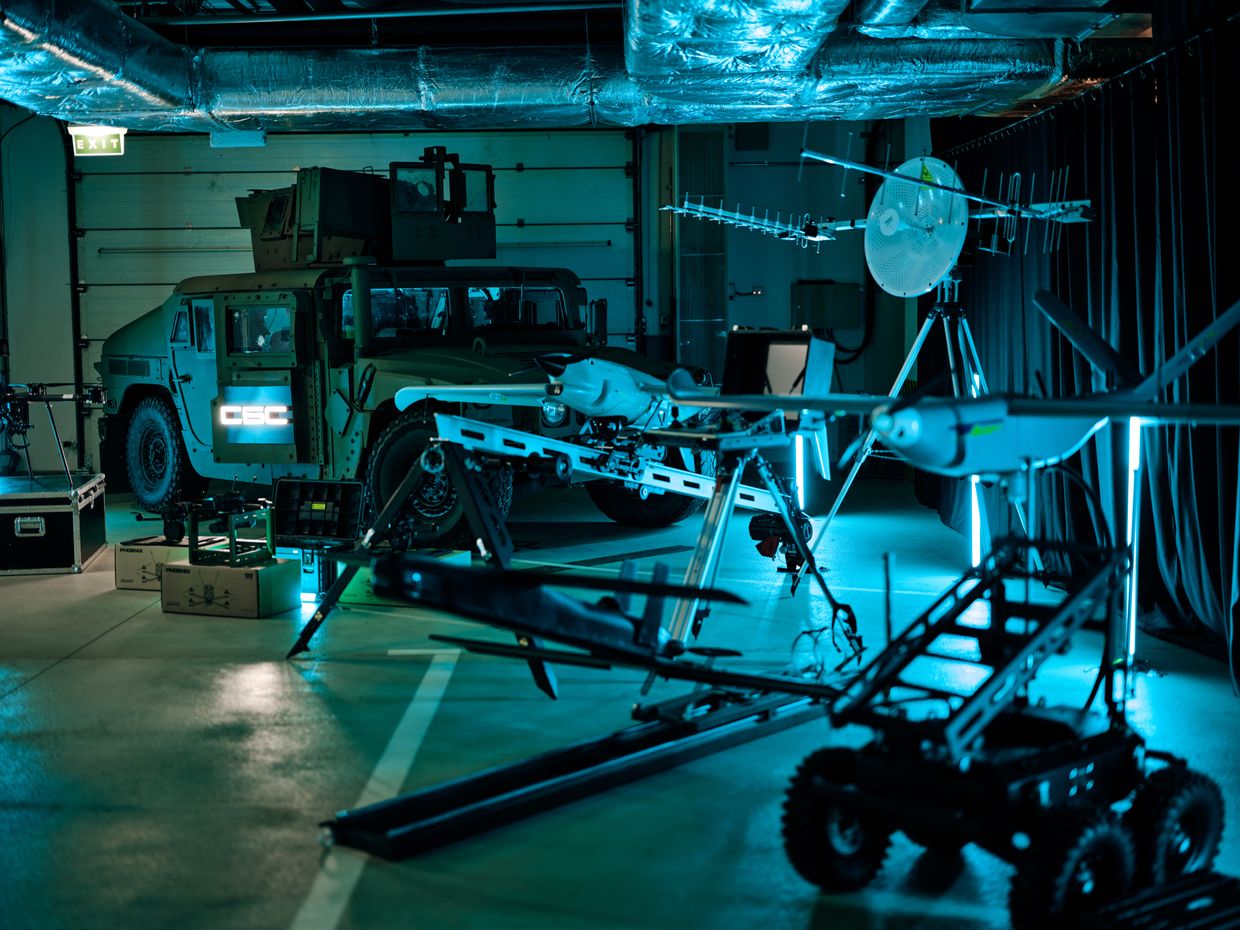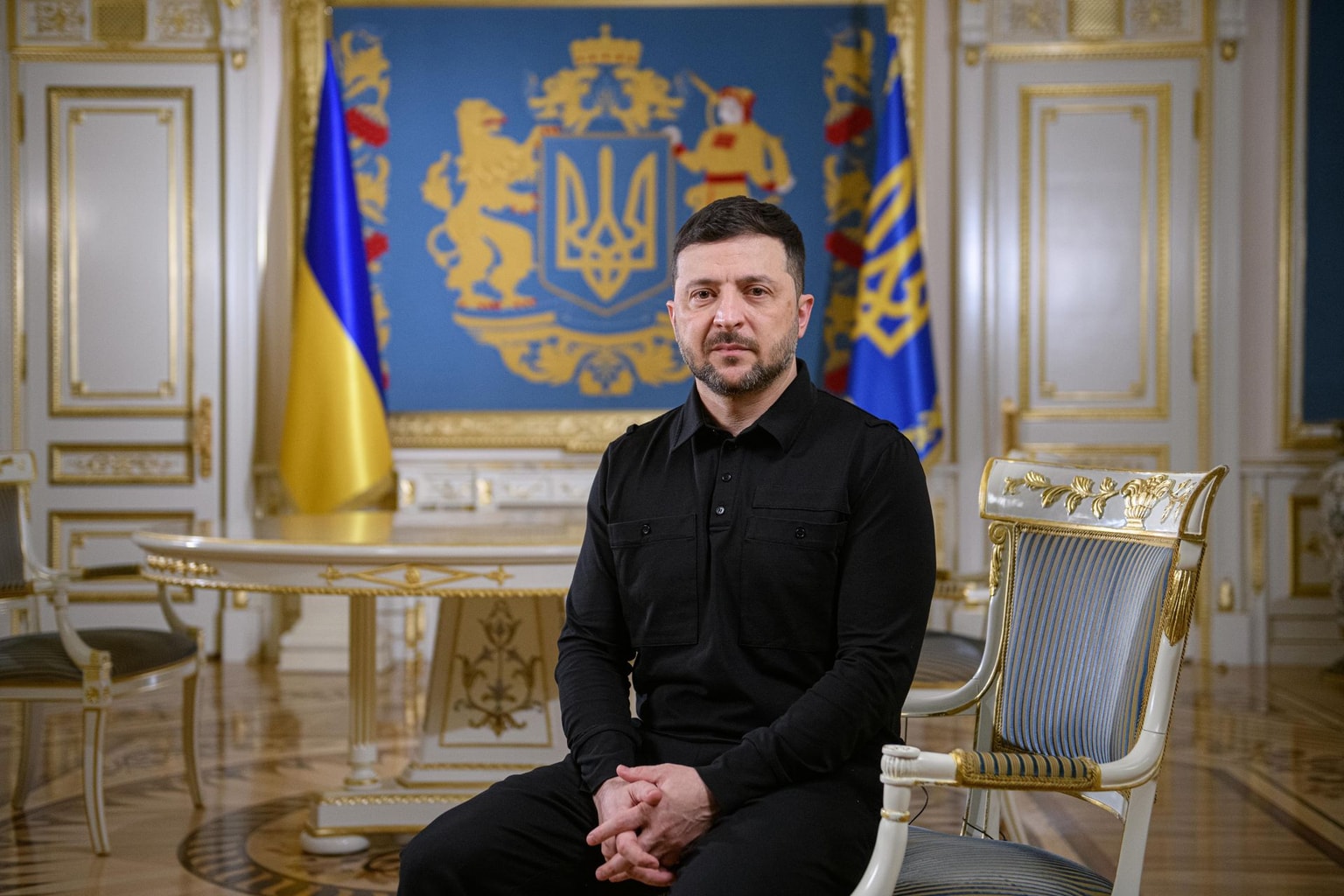
Ukraine’s robotic army is bringing the fight to Russia
Ukraine’s robotic revolution is reshaping modern warfare — and the future of combat.
A robot dog is tested with fiber-optic-controlled drones at an undisclosed location in Kyiv Oblast, Ukraine, on Jan. 29, 2025. (Tetiana Dzhafarova / AFP via Getty Images)
Ukraine has become a war lab for the future since the onset of Russia’s full-scale invasion. Driven by necessity, it has had no choice but to rely on rapid innovations to fight back. As a result, Ukraine is at the forefront of military technology, leveraging robotics and automation to redefine modern warfare and serve as a testing ground for future combat technologies.
As it continues to develop and deploy cutting-edge unmanned systems, the world is closely watching how these advancements shape the battlefield. Given that Ukraine is already using AI-enabled drones, the deployment of autonomous ground robots may become a reality sooner than expected.
Now, Ukraine is building a robotic army, aiming to have more than 200 uncrewed ground vehicles (UGVs) in operation by the end of the year. As it continues deploying these robots, it is gathering valuable data and insights that will shape the development of future autonomous systems. This experience positions Ukraine to train AI models and lead the way in deploying next-generation autonomous robots when the time comes.
In a November 2023 interview with The Economist, former Ukrainian Commander-in-Chief Valerii Zaluzhnyi described the war as "positional," warning that the prolonged conflict threatens not only Ukraine's military but the survival of the state itself. He said breaking the deadlock would require a major technological leap.
With dwindling Western arms supplies and a resource-rich adversary, Ukraine is turning to technology to level the playing field. What started with drone warfare has expanded to advanced robotic systems, marking a new chapter in Ukraine’s fight against a much larger invader.
In December 2024, Ukrainian forces reached a milestone by launching their first successful attack on Russian positions using only ground and FPV drones — demonstrating the growing sophistication of Ukraine’s unmanned warfare. According to Sgt. Volodymyr Dehtiarov of the Khartiia Brigade, dozens of robotic and unmanned systems, including machine-gun-equipped ground drones and kamikaze FPV drones, were deployed near Lyptsi, north of Kharkiv.
The Institute for the Study of War (ISW) commented on the attack, writing, "Ukrainian officials have repeatedly highlighted Ukraine's efforts to utilize technological innovations and asymmetric strike capabilities to offset Ukraine's manpower limitations in contrast with Russia's willingness to accept unsustainable casualty rates for marginal territorial gains."
"Ukrainian officials have repeatedly highlighted Ukraine's efforts to utilize technological innovations and asymmetric strike capabilities to offset Ukraine's manpower limitations in contrast with Russia's willingness to accept unsustainable casualty rates for marginal territorial gains."
While Russian casualties have surpassed 750,000, Ukraine continues to innovate with systems like the Honey Badger unmanned ground vehicle — an explosive-laden robot designed to infiltrate and neutralize armored targets.
Recognizing the potential of such advancements, Ukrainian authorities established the BRAVE1 defense innovation initiative in spring 2023 to streamline cooperation between the military, state institutions, private sector developers, and investors, fostering a more efficient and coordinated approach to defense technology.
Ukraine previously used a ground robot to help assault a Russian trench in Kursk Oblast in September 2024. With a significant manpower disparity along the nearly 1,300-kilometer (800-mile) front line, Ukraine has no choice but to maximize its technological capabilities, deploying an array of unmanned systems to support its forces. One Ukrainian official noted that "Ukraine has made the most of turning industrial disadvantage into a furnace of innovation."
Technological advancements in the war have moved quickly, but a key challenge is organizing research, development, testing, and the integration of various systems across all units. In February 2024, Ukrainian President Volodymyr Zelensky created the National Unmanned Systems Forces (USF), appointing Col. Vadym Sukharevskyi as commander in June 2024.
Ukrainian startups are playing a crucial role in advancing battlefield technology, with around 250 companies contributing to the war effort. One such startup developed an unmanned ground vehicle called the Odyssey in just four days in a shed, costing only 10% of what an imported model would. "We are fighting a huge country with no resource limits. We know we cannot afford to lose many lives," said Denysenko, head of the defense startup UkrPrototyp. The BRAVE1 initiative has already successfully tested more than 50 ground-based systems.
UNITED24, the fund launched by Zelensky, also began raising money for a ground-based robotic platform, noting, "These robots aim to save lives on the battlefield and among civilians by serving as logistical support, evacuators, mine layers, and deminers, as well as combatants."
Warfare is entering an era where victory may no longer depend on manpower but on the ability to sustain and replenish robotic assets. Future conflicts may be fought until one side can no longer afford to replace its machines — an unsettling yet increasingly plausible scenario in modern warfare.
This shift is evident in how drones are used on the battlefield. Ukrainian drone operators, stationed miles behind the front lines, are orchestrating strikes with precision from a distance — highlighting the radical transformation of 21st-century warfare. Just as British redcoats once used volley fire to dominate spear-wielding adversaries in the 18th century, today's conflicts are seeing a similar technological disparity, where unmanned systems grant those with superior technology a decisive advantage.
However, robots alone cannot solve Ukraine's manpower shortages. Still, Ukraine is actively working to develop a force of battlefield robots to minimize human involvement and save lives. As one Ukrainian official explained, "We count people, and we want our people to be as far from the front line as we can."
"However, robots alone cannot solve Ukraine's manpower shortages."
Ukraine plans to deploy tens of thousands of uncrewed robotic ground vehicles this year to transport supplies, evacuate wounded soldiers, and support infantry in trench warfare, according to Ukrainian Deputy Prime Minister Mykhailo Fedorov. These buggy-like vehicles, already in use along the front and in Russia's Kursk Oblast, help reduce risks to troops under heavy Russian shelling and drone attacks. Fedorov, who has played a key role in overseeing Ukraine’s drone procurement, has been a leading force in fostering private-public innovation in military technology throughout the war.
Ground-based robots are poised to play an increasingly critical role in Ukraine's war effort, excelling at tasks like loitering — remaining in high-risk areas for extended periods, something human soldiers struggle to do safely. These robotic systems are used for reconnaissance, persistent surveillance, and logistics, such as delivering supplies and evacuating wounded soldiers under fire. Unlike humans, robots can operate tirelessly and withstand prolonged exposure to dangerous environments, providing continuous battlefield support.
Retired U.S. Army Gen. Mark Milley has projected that robotic systems could make up a third of the U.S. military within the next decade, underscoring the broader implications of Ukraine’s technological progress.
Despite these groundbreaking advancements, Ukraine's success still depends on sustained Western support to strengthen its battlefield position ahead of potential peace negotiations. Its resourcefulness and ability to rapidly develop and deploy cutting-edge unmanned systems have positioned Ukraine as a potential global leader in modern warfare technology. If Ukraine emerges from this war as a free and sovereign state, it is well-positioned to become a powerhouse in developing next-generation combat systems that could shape military doctrine for years to come.
Editor’s Note: The opinions expressed in the op-ed section are those of the authors and do not necessarily reflect the views of the Kyiv Independent.













